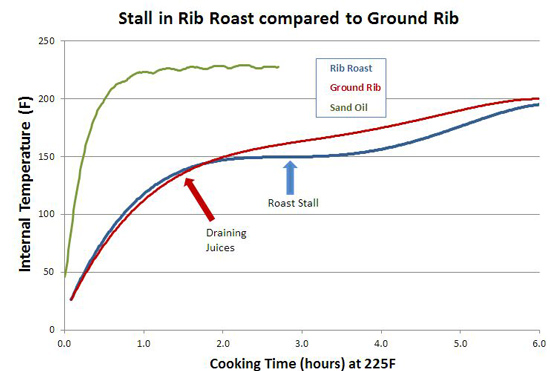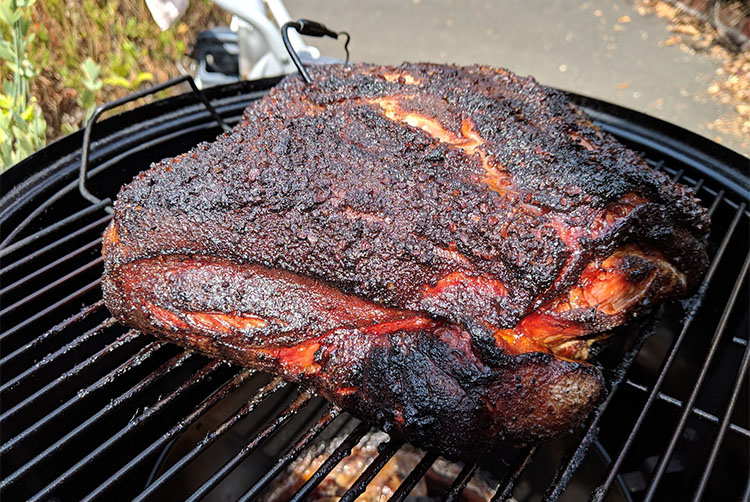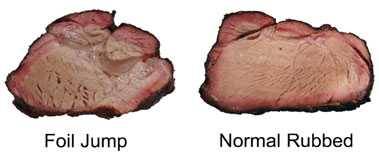What Is Brisket Stall Temp?

The Brisket Stall Temp refers to the point during the smoking process when the internal temperature of the brisket plateaus and stops rising. It typically occurs around 160 to 165 degrees Fahrenheit and can last for several hours. This phenomenon can be frustrating for BBQ enthusiasts as it seems like the temperature is not progressing. However, it is a crucial stage in the cooking process as it allows the connective tissues in the brisket to break down, resulting in a tender and flavorful end product. Understanding and managing the brisket stall temp is essential for achieving the perfect smoked brisket.
Definition Of Brisket Stall Temp
The Brisket Stall Temp refers to the point during the smoking process when the internal temperature of the brisket plateaus and stops rising. It typically occurs around 160 to 165 degrees Fahrenheit and can last for several hours. This phenomenon, also known as the BBQ Stall, can be frustrating for BBQ enthusiasts as it seems like the temperature is not progressing. However, it is a crucial stage in the cooking process as it allows the connective tissues in the brisket to break down, resulting in a tender and flavorful end product. It is important to understand and manage the brisket stall temp to achieve the perfect smoked brisket.
Causes Of The Brisket Stall
The brisket stall occurs primarily due to the process known as evaporative cooling. As the brisket cooks, moisture from the surface of the meat evaporates, creating a cooling effect that counteracts the heat of the smoker. This cooling effect slows down the rise in internal temperature, causing the stall. Additionally, the breakdown of connective tissues in the brisket, including collagen, also contributes to the stall. These tissues need time to break down and become tender, which can further prolong the stall. By understanding the causes of the brisket stall, BBQ enthusiasts can better navigate this crucial stage in the smoking process.
How To Overcome The Brisket Stall

To overcome the brisket stall, there are a few methods BBQ enthusiasts can employ. One option is to increase the cooking temperature. By cooking the brisket at a higher heat, such as 290-350°F, the stall can be shortened as the evaporation process is accelerated. Another technique is to wrap the brisket in foil or butcher paper, known as the Texas crutch method. This helps to speed up the cooking process and prevent moisture loss, ultimately pushing through the stall. Additionally, some pitmasters opt to use a water pan in the smoker to increase humidity and minimize the cooling effect. By implementing these strategies, you can successfully navigate and overcome the brisket stall, ensuring a delicious and tender end result.
Methods To Push Through The Brisket Stall
There are several methods that can be used to push through the Brisket Stall and continue the cooking process. One effective technique is to increase the cooking temperature. By raising the heat to around 290-350°F, the brisket will cook faster and the stall can be shortened. Another method is to wrap the brisket in foil or peach butcher paper. This helps to retain moisture and speeds up the cooking process. Additionally, some pitmasters choose to use a water pan in the smoker to increase humidity and minimize the cooling effect. These methods can help overcome the stall and ensure a deliciously cooked brisket.
Tips For Managing The Brisket Stall
When faced with the Brisket Stall, there are a few tips that can help you manage the situation and ensure a successful outcome. First, be patient and resist the temptation to rush the process. It’s important to allow the stall to run its course naturally. Second, keep an eye on your cooking temperature and make any necessary adjustments to maintain a steady heat. Third, consider using a water pan in your smoker to help maintain moisture levels and minimize the cooling effect. Lastly, if time is a concern, you can increase the cooking temperature slightly to push through the stall more quickly. By following these tips, you’ll be better equipped to manage the Brisket Stall and achieve a perfectly cooked brisket.
Factors Affecting The Brisket Stall Temp

The Brisket Stall Temp can be influenced by various factors, which can impact the cooking time and overall tenderness of the brisket. One such factor is the meat thickness. Thicker cuts of brisket tend to take longer to cook and may experience a more extended stall. Additionally, the humidity and airflow within the smoker play a role in the stall. High humidity levels can prolong the stall, while proper airflow helps maintain temperature consistency. Pitmasters should also consider the quality of the meat, including its tenderness and fat content, as these factors can affect the stall as well. By understanding these factors, pitmasters can better navigate and manage the brisket stall for optimal results.
Understanding The Impact Of Meat Thickness
The thickness of the meat plays a significant role in the brisket stall. Thicker cuts of brisket will take longer to cook and may experience a more extended stall than thinner cuts. This is because thicker pieces of meat require more time for the heat to penetrate through to the center. As a result, the internal temperature of the brisket may plateau and remain stagnant for an extended period. Pitmasters should be aware of this and plan accordingly, allowing for additional cooking time to ensure the meat reaches the desired internal temperature and tenderness.
The Role Of Humidity And Airflow In The Brisket Stall
Humidity and airflow play a crucial role in the brisket stall. The balance between these two factors can greatly influence the duration and intensity of the stall. High humidity levels in the smoking chamber can result in increased evaporation, causing the brisket to cool down. On the other hand, low humidity can lead to excessive moisture loss, drying out the brisket. Properly managing the airflow is also important. Sufficient airflow allows for the removal of smoke and heat, helping to prevent a buildup of moisture and heat around the meat. By finding the right balance of humidity and airflow, pitmasters can effectively navigate through the brisket stall and achieve the desired results.
Importance Of Resting Brisket Post Stall

Resting the brisket post stall is a crucial step in the smoking process. After patiently waiting for the meat to overcome the stall, allowing it to rest is essential for achieving optimal tenderness and juiciness. Resting allows the meat to reabsorb the juices that were lost during the cooking process, resulting in a more flavorful end product. Additionally, resting helps to evenly distribute the internal temperature of the brisket, ensuring that the meat is cooked to perfection. It is recommended to let the brisket rest for at least 30 minutes to an hour before slicing and serving. This short resting period can make a significant difference in the overall taste and texture of the brisket.
Resting Period After Overcoming The Brisket Stall
Once you have successfully pushed through the brisket stall, it is crucial to allow the meat to rest before slicing and serving. During the resting period, which should last for at least 30 minutes to an hour, the brisket continues to cook internally, reaching a state of tenderness and juiciness. This resting period allows the meat to reabsorb the juices lost during the cooking process, resulting in a more flavorful end product. It also helps to distribute the internal temperature evenly throughout the brisket, ensuring that every bite is cooked to perfection. So, resist the temptation to immediately slice into the brisket and give it the time it needs to rest and reach its full potential.
Benefits Of Allowing The Brisket To Rest Properly
Allowing the brisket to rest properly after overcoming the stall is crucial for achieving the best results. During this resting period, the brisket continues to cook internally, reaching a state of tenderness and juiciness. The resting period, which should last for at least 30 minutes to an hour, allows the meat to reabsorb the juices lost during cooking, resulting in a more flavorful end product. Additionally, the resting period helps to distribute the internal temperature evenly throughout the brisket, ensuring that every bite is cooked to perfection. So, resist the temptation to immediately slice into the brisket and give it the time it needs to rest and reach its full potential.
Popular Brisket Stall Myths Debunked

There are several myths surrounding the brisket stall that have been debunked by barbecue experts. One common misconception is that wrapping the brisket in foil will shorten or eliminate the stall. However, this is not true. While wrapping the brisket can accelerate the cooking process, it does not bypass the stall. Another myth is that increasing the cooking temperature will prevent the stall. In reality, the stall is a natural part of the cooking process and cannot be completely avoided. Understanding these myths will help barbecue enthusiasts better navigate the brisket stall and achieve the perfect smoky, tender brisket.
Common Misconceptions About The BBQ Stall
One common misconception about the BBQ stall is that wrapping the brisket in foil will shorten or eliminate the stall. However, this is not true. While wrapping the brisket can accelerate the cooking process, it does not bypass the stall. Another myth is that increasing the cooking temperature will prevent the stall. In reality, the stall is a natural part of the cooking process and cannot be completely avoided. Understanding these myths will help barbecue enthusiasts better navigate the brisket stall and achieve the perfect smoky, tender brisket.
Dispelling Myths Surrounding Brisket Stall Temp
One common misconception about the BBQ stall is that wrapping the brisket in foil will shorten or eliminate the stall. However, this is not true. While wrapping the brisket can accelerate the cooking process, it does not bypass the stall. Another myth is that increasing the cooking temperature will prevent the stall. In reality, the stall is a natural part of the cooking process and cannot be completely avoided. Understanding these myths will help barbecue enthusiasts better navigate the brisket stall and achieve the perfect smoky, tender brisket.
Conclusion

In conclusion, understanding the phenomenon of the brisket stall temp is crucial for achieving perfect smoked brisket. The stall occurs when the internal temperature plateaus around 160-170°F (71-77°C) due to evaporative cooling. While there are various methods to overcome the stall, such as wrapping in foil or increasing cooking temperature, it is important to note that the stall is a natural part of the cooking process that cannot be completely avoided. Resting the brisket after overcoming the stall is also essential to allow the juices to redistribute and ensure a moist and flavorful end result. By dispelling common myths and properly managing the stall, pitmasters can attain tender and delicious brisket every time.
Final Thoughts On Understanding The Brisket Stall
Understanding the brisket stall is an essential skill for any serious pitmaster. By grasping the concept and causes of the stall, as well as effective methods to overcome it, you can take your brisket smoking to the next level. Don’t be discouraged by the stall; it’s a natural part of the cooking process. Embrace it and use it as an opportunity to perfect your techniques. Remember to rest your brisket properly after overcoming the stall to ensure maximum tenderness and flavor. With patience and practice, you’ll be able to consistently achieve mouthwatering results every time.
Key Takeaways And Recommendations For Successful Brisket Smoking
When it comes to achieving a perfectly smoked brisket, there are a few key takeaways and recommendations to keep in mind. First and foremost, embrace the learning curve that comes with mastering the brisket stall. It may take time and practice to understand its nuances, but don’t be discouraged. Use the stall as an opportunity to refine your skills and experiment with different techniques.
Additionally, be patient and allow ample time for the brisket stall to run its course. Rushing the cooking process can result in a subpar final product. Remember, good things take time. Finally, don’t be afraid to seek out resources and learn from others who have mastered the art of brisket smoking. There is a wealth of knowledge and tips available to help you achieve barbecue perfection. So, enjoy the journey and savor the mouthwatering results that come from successfully smoking a brisket.
FAQ About Brisket Stall Temp: Understanding The BBQ Stall
Q: What is the BBQ stall or brisket stall?
A: The BBQ stall, also known as the brisket stall, is a phase during low and slow smoking when the internal temperature of the meat plateaus. This can last for several hours, causing frustration to many pitmasters.
Q: Why does the brisket stall occur?
A: The brisket stall occurs due to evaporative cooling. As the meat’s moisture evaporates during cooking, it cools the surface of the meat, creating a barrier that slows down the temperature increase.
Q: How long does the brisket stall last?
A: The brisket stall can last for a few hours, depending on various factors such as the size of the brisket, the cooking temperature, and the humidity in the smoker. It is common for the stall to occur when the brisket’s internal temperature reaches around 150-170°F (65-77°C).
Q: How to overcome the brisket stall?
A: To overcome the brisket stall, you can wrap the brisket in foil or butcher paper once it enters the stall phase. This method, known as the Texas crutch, helps to power through the stall by retaining heat and moisture around the meat.
Q: Should I be concerned about the brisket stall?
A: No, the brisket stall is a natural part of the smoking process and is nothing to be concerned about. It is essential to be patient and allow the meat to continue cooking until it reaches the desired tenderness.
Q: Can I speed up the brisket stall?
A: While trying to speed up the brisket stall goes against the low and slow cooking method, some pitmasters choose to increase the cooking temperature slightly to push through the stall faster. However, this may affect the final texture and moisture of the brisket.
Q: How to ensure a successful brisket cook despite the stall?
A: To ensure a successful brisket cook despite the stall, it is crucial to maintain a consistent cooking temperature, monitor the internal temperature of the meat using a reliable meat thermometer, and plan ahead by allowing enough time for the stall phase.

The Stone’s Sports Grill and Bar was Established on December 1, 2021. The Stone is a Sequel to another restaurant called Cornerstone’s First Edition in Tucumcari, NM. This particular venue is located on the Southeast side of Colorado Springs. The Stone is Wide Open. We have a large dance floor, multi-level stage, pool room, (5) dart boards, and a bar with a large selection of wine spirits and brews.